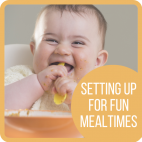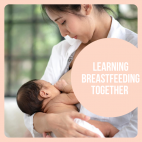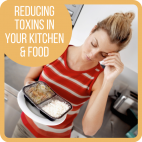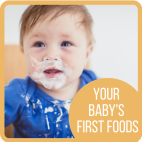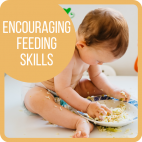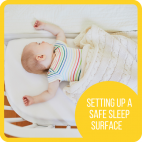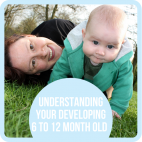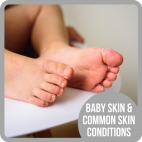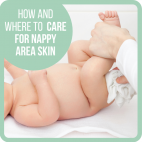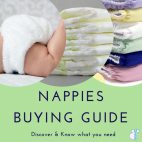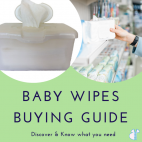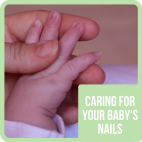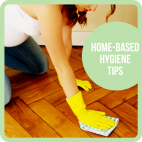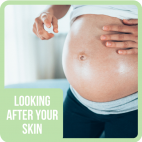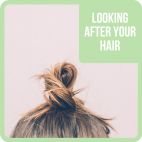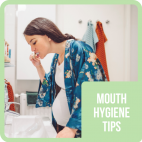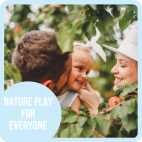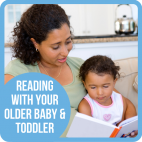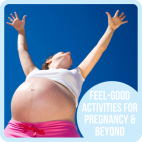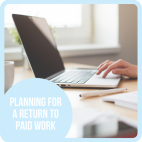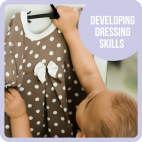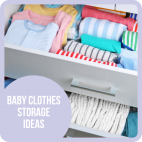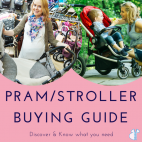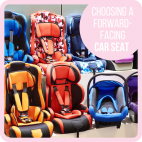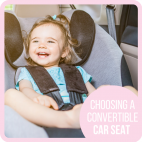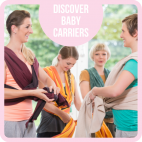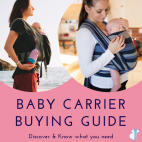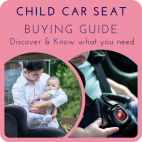Your curious little explorer
Once your little explorer works out how to sit up and do more on their tummy, they have a new perspective on the world. They are getting more mastery over their bodies and more ways to get where they want to touch and interact with objects. They will continue to put most things into their mouth as an efficient way of exploring the object, so be mindful of everything they have access to. It's time to take action on babyproofing your spaces because your baby will soon be into everything (especially what you don't want them to).
Each month, your baby is building on their gross movement skills, from sitting, crawling, standing with support, standing without support, and taking their first steps around their 1st birthday (some will take longer). Each baby will follow their own timeline for their development. As long as you provide plenty of opportunities to practice, they will continue to build on their strength and skills at their own pace. If they are not walking yet, they may be great with their hands, or talking earlier than expected, they choose what skills they want to work on first based on what they are interested in. If you watch closely, you can see their personality coming through. They will have likes and dislikes and preferences. It will be useful to understand your developing 6 to 12 month old which is why we have written an article on that exact topic!
Your baby understands more of what you say, responding to their name and common words such as 'no' and 'bye'. They will start to experiment on their first sounds, which will become their first words. They are great imitators, so will be watching everything you do, start to repeat words, experiment with gestures such as waving goodbye, and by 12 months start to participate in tasks such as dressing and feeding.
Life is never dull with your baby growing up and becoming a little person. They still are so dependent on you even though they are starting to try out doing some things for themself. If you are breastfeeding, there is still plenty of reasons to keep going. Do what feels right for you and your baby, for as long as it feels right. Each day will have it's own challenges and triumphs, roll with it, get creative and be kind to yourself.
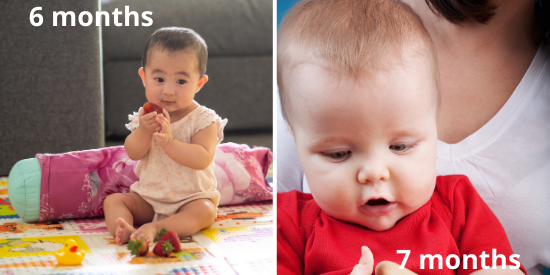
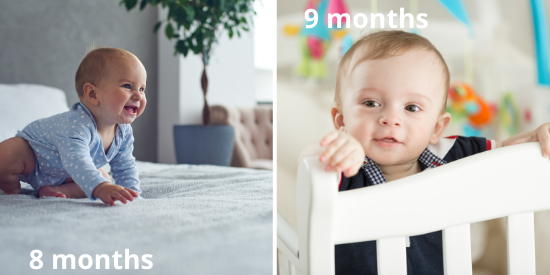
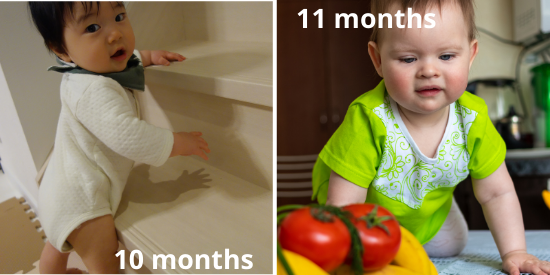
From around 6 months is the typical time to start slowly introducing solids or family foods. It is helpful to know that these is just the first steps in a years-long process, so patience will be needed as well as tolerance for mess!
The first stages of weaning are more of a sensory and motor learning experience than to meet any nutritional goals. Exposing them to different family foods helps with learning how to chew, swallow, put things in their mouth and experience a wide range of tastes, textures, colours and flavours. Sometimes they will barely eat anything, and that's ok. Sometimes teething will interfere with their appetite and mood. Your baby's milk feeds still provide the majority of the nutrients your baby needs during this stage. The only consideration is that in general your baby's natural iron levels start to drop at this age and they start to need to source the iron from their diet. It is generally recommended to introduce iron-rich foods where possible.
Water can be offered in sippy or straw cups between milk feeds. Your baby's first teeth can start to emerge as early as 6 months or as late as 10 months on average. By 12 months, they could have as many as 8 front teeth. From the earliest age, diet is an important part of supporting healthy teeth including avoiding high sugar drinks (such as juice) due to the damage it can do to the baby tooth enamel. By the end of this stage your baby should no longer need to use baby bottles for milk feeds. Instead, from 12 months, they can graduate to use a sippy or normal cup.
You will know when the timing is right to start introducing family foods because your baby will be displaying certain skills and passing the necessary developmental milestones. Check out Your Baby's First Foods, Setting Up for Fun Meal Times and Encouraging Feeding Skills for more info on these topics.
As your baby is able to have longer stretches of awake time between day time naps, the night stretches of sleep may become longer. Nighttime waking is still common, as well as the need for night feeds.
As a rough guide, babies between 6 to 12 months old sleep during the day for around 2.5 hours (averaging 2 - 3 hours awake time between their 2-3 naps) and during the night, an average of 9 -12 hours. In total, 14-17 hours (with a range of between 11 and 19 hours). The averages serve to give you an idea of what the awake/sleep rhythms of your baby's day might be, but each baby will be unique in their sleep needs.
6 months is the earliest age recommended for babies to sleep in their own room due to the increased SIDS risk before 6 months. This is a great time to re-evaluate what is working and not working with the sleeping arrangements, explore your options and work towards transitioning to something more workable. It is important to continue to follow the safe sleeping guidelines to set up a safe sleeping surface, but now with it is mind to keep them safe from to falls out of bed, trying to climb out of bed and making the surfaces teething safe. Your crawling baby could benefit from some coaching once they start to crawl in how to go feet first rather than head first off surfaces such as the bed, couch and steps.
Just when you are getting somewhere with their sleeping, it is common for your baby to experience a 9-month sleep regression. This again means more night waking, night feeds and parent contact at night due to separation anxiety related to this developmental leap.
During times when your baby is working on a new movement skill, the drive to practise these new skills can interfere with sleep. They can have difficulty calming down to sleep, staying in one place when put down on their back to sleep and even when they have gotten to sleep, they can suddenly be on the move between sleep cycles and may need resettling.
Another sleep stealer is if your baby is in any pain or discomfort related to colds, nasal blockage, and teething. They may need some form of pain relief or need a good cry to release the underlying tension built up over the day.
If they haven't already done so (or ever did), your baby will have grown out of the need to be swaddled. It is not recommended to continue with swaddling once they are rolling as it could interfere with their ability to move back into a safe sleeping position if they manage to roll themselves over in their sleep. If they continue to enjoy the deep pressure of the swaddle, there are transition sleeping bags in large sizes you could try that could provide this such as the Woombie Convertible Swaddle, bblüv - Sleëp - 3-in-1 Evolutive Swaddle (Large), and the Tommee Tippee The Original Grobag Snuggle. Progressing to a sleeping bag is a great option at any time. You might want to buy a few to suit your baby's size and the season such as from Ergobaby or The Stork Nest or Amazon Au - that way you have a spare or two should one get soiled in the night.
Looking after the health of your family is always going to be one of the most important things you can do. Your baby continues to grow and develop their skills in all areas of life and it's amazing to watch. At this age, your baby is more focussed on moving, exploring and understanding their world than anything else. Getting them to nap without getting over tired can be a challenge, introducing family foods can be frustrating and there are still a lot of changing of nappies and clothes to manage everyday.
Continuing to breastfeed your baby is known to be protective for their health as you pass antibodies through your milk for any illness the family might have or you have had in the past. This doesn't mean your baby will never get sick, it is more that their symptoms can be kept to a minimum as their immune system is being assisted and trained to fight back. Keeping your baby's nose clear can sometimes be a challenge if they have stuck snot or are producing mucus. Since babies are nose breathers it is important to keep their noses clear and helps to prevent them from getting into a habit of mouth breathing (which can lead to airway and oral problems down the track).
The average age range for first teeth to erupt is between 6 to 10 months with the first 2 teeth emerging through the bottom middle (known as the lower central incisors). It is very cute when their first two bottom teeth emerge where there were only gums before. The first teeth are the start of a long run of teething periods which will settle down at around 2 years and up to 3 years when the last molars emerge to make a full set of baby teeth.

When your baby starts to get their teeth, it is horrible to think that they could become one of the 42% of 5-10 year olds in Australia to develop decay in their baby teeth. It is clear that mouth health is not just about brushing and avoiding sugar, there's a lot more to it. The hardest substance in the body, 10x harder than bone are your teeth. To make strong teeth, the body needs nutrients including vitamin A, D, E and K2 both from the sun and food sources. For the jaw, mouth and nasal/airway structures to grow and develop normally, functional dentists such as Dr Steven Lin advocate that using the jaw to chew, resting the tongue at the top of the mouth and using the nose for breathing (rather than mouth breathing) contributes to the growth of normal structures and helps with creating space for all the teeth to emerge and healthy gums. It's worth knowing sooner rather than later what you can do to help your baby to enjoy a healthy life starting with their mouth health.
This is a great age for wearing absorbent bibs to protect their clothes from getting drool soaked. An absorbent bib will also serve to protect their skin which if left moist, can develop a mild skin rash.
As always, don't forget about your own health. The health and wellbeing of Mums and Dads is so important for the family unit to function. Continue to do what energises you, honour your self-care routines and prioritise getting enough sleep over anything that can wait or doesn't really need to be done. Remember to laugh and see the beauty in your life and how your baby is growing. You are doing a great job!
Hygiene at this age is all about bathtime fun, distracting your baby long enough to get their nappy changed, brushing first teeth, and meeting their teething needs.
A balanced approach to sanitation and cleanliness around your baby is a good idea so that they receive a healthy dose of microbes to help their immune system develop. There have been links found between increased sanitation in industrialized countries and increases in asthma in children and other immune related illness as is further explored in the book Let Them Eat Dirt. This is also another reason to let your baby play with their food, as this exposes their body to the food and any associated microbes before any gets into their mouth.
If you bought a baby bath, your baby may be starting to grow out of this now that they will want to start sitting up for their bathtime. You'll need a bath or tub which is supportive but won't tip over such as the Shnuggle Bath which has a toddler model for when your baby is growing out of the 0-12 month model. If all else fails, a washing basket in a large bathtub works as good as anything. Your baby will love bath toys that help them understand how water works such as pouring and floating toys or cups. Just make sure the toys can dry out fully between uses or they will start to grow mould!
New foods along with teething and skin irritation can cause nappy rash which should be managed using a zinc based nappy cream, thoroughly cleaning of the area during nappy changes with soft wipes, encouraging no nappy time during the day, (easier in summer months) and extra baths or water play.
For managing teeth and gums, your baby will be needing their first toothbush such as in the Jack N' Jill range and might enjoy you rubbing their gums with a cold or frozen wet washer and having a range of teethers which are safe to chew on.
This age stage is a very busy time for your baby's social, brain and motor development. In 6 months, your baby can progress from working on sitting balance, to walking! Crawling is an important milestone for your baby to pass through for many reasons. If your baby is trying to skip the crawling phase, it's worth actively encouraging them to crawl for a period of time. Your baby will also be practising using their hands to mature their grasp, to progress towards being able to play with and manipulate objects in new ways.
As they go through their distinctive cognitive leaps (usually 3 during these 6 months), they are seeing the world through new eyes and experimenting like a little scientist. They are also developing socially, starting to understand and respond to familiar words, maybe attempting simple sign language & gesturing, and experimenting with different babbling sounds which lead into first words. Your baby will benefit from you talking and interacting with them as much as possible, where it can feel like you are their narrator for your baby's daily life story. As always, you can help develop their interaction and communication skills by reading to your baby everyday. If you're after ideas on what books to buy, check out our blog on Award-Winning Australian Authors & Books, then be sure to check out the topic article on Reading with your baby and Reading with your older baby & toddler. Your baby will also delight in all sorts of music, action rhymes, songs and games. You can enjoy the nostalgia of re-learning forgotten words to nursery rhymes and acting silly just for giggles - why not?
Your baby's new-found mobility can leave you with mixed feelings. At the same time you can be both upset and missing your immobile baby who used to stay where you put them, and be their biggest fan, admiring and applauding their new abilities. There is no holding them back though, baby's are driven! Their curiosity, ability to reach new places and need to put everything in their mouth can keep you on your toes for sure. If you didn't already get around to baby-proofing your spaces, there's no more putting it off, and no time like the present. As your baby reaches new heights, you will need to find higher surfaces to put the breakables and otherwise adult things you don't want your baby getting their hands on. For somewhat mystical reasons, baby's seem to have the ability to read minds and as soon as you see something you don't want them to get into, they are pulled magnetically in that direction, and that's exactly what they go for next! You'll need to be one step ahead of them.
If the time for your return to work is approaching, you may be starting preparations such as working out childcare arrangements, preparing for the transition to childcare, figuring out adjustments to feeding arrangements and the mental and emotional preparation for being away from your baby. By agreement, many childcare centres will use the cloth nappies and wet bags you send with your baby, this is a great option if you are using cloth at home and want to continue full-time. To make things more complicated, at around 8 months, separation anxiety can start and continue, reaching its peak in babies aged 14-18 months. Separation anxiety can be something you very much feel as well, along with a whole range of emotions. Try to keep an open mind to your options and do what feels right for you and your baby.
With first teeth emerging over this age stage, an essential clothing item is a great bib which will catch and absorb the endless supply of drool. Find a brand you love and stock up! You can find bibs at Designer Bums in so many colourful designs, at the eBay Baby Bunting Store, Etsy, or Amazon Au.
Onesies are still a great wardrobe staple to stick to since your baby will love to be carried and love to move and you need clothes that are going to stay in place. When your baby is approaching their first birthday, you might want to have some more 2 piece outfits for during the day. They will be spending more time on the floor working on their crawling skills. You might want to go for some darker or bright colours that hide stains well since your baby will be very good at getting dirty and messy eating. Clothes with large prints on the front are great at repelling stains. If it is warm, less is often more where just a nappy is all that is needed.
Once your baby is mobile and starting to get steadier on their feet, a whole world of new skills can start to develop. They are developing strength, balance, coordination, and the ability to make choices which all contribute to their ability to become more active in the dressing process. Check out Developing Dressing Skills for more information on this topic including hints and tricks that encourage engagement.
Socks and shoes can be difficult to keep on anytime after your baby discovers their feet. In saying that, your baby might not mind wearing socks at all! Once they start to crawl, socks can help to protect their feet and crawling knee pads can help protect their knees and give them some grip on slippery surfaces such as tiles and floorboards. Shoes really aren’t necessary until baby is walking confidently to protect their feet on uneven ground if you think they need to. Where possible, encourage bare feet as the best way for your baby to learn to move. The feedback they receive through their feet muscles and skin to their brain gives them information about where their body is in space and helps to develop a greater body awareness.
Need to stock up on baby clothes for this stage?
- Shop Etsy baby girl's clothing & Baby Boy's clothing for unique, handmade and vintage clothes and shoes
- Why not search for second-hand clothes at your local op-shop or on eBay?
- The wonderful thing about community is that there is always hand-me-downs floating around, so before you buy anything, see if any of your friends or family with older children are looking to hand down any clothes or shoes.
- For new or special items, also check out ebay stores such as Baby Bunting and new listings, Amazon Au
Now that your baby is getting more mobile and starting to sit up, you have more options for transporting your baby around short distances and long distances. Look for products which fit your lifestyle, what your body can manage to push/carry/lift, local environments, and where else you will need to take your baby. You can use any combination of the following at different times:
- carrying (in arms/sling/carrier) - Carrying your baby has many benefits for both you and your baby. Using a long piece of fabric to wrap your baby onto your body is a traditional practice for good reason. There are lots of carrier and sling options available to give you a hands-free option for walking around with your baby. It is worth investing in at least one of these.
- car or public transportation - To travel in a car, you will continue to need a child car seat. Now that your baby is starting to sit up, they can legally be faced forward in a forward facing or convertible car seat. If you have had your baby in a capsule car seat, it could be time to upgrade your seat. See our guide to choosing car seats below for what to consider. Until your baby is over 12 months old, when travelling in a taxi, they must be in a child restraint seat. In these cases, you can bring your own seat or ask for the taxi with a car seat. For travelling on public transportation, a small to medium-sized pram and/or carrier can be great options.
- Combination Pram/stroller or stroller - If you have a Combination pram/stroller, you can be confident in sitting your baby more upright in the seat when they are alert. You still have the option to lay the seat flat when they have a nap in the pram. Strollers and jogging strollers are designed to be used from 6 months old, but not before. Your baby will enjoy being about to see the world in outward facing seats and some will still want to face you at different times. Having the option to face your baby to you or face them out can come in handy to cater to their mood and preferences as they change. When it comes to looking around and choosing what is going to suit you, it all gets very confusing because there are so many brands and so many models available. You need to know what you want and need before you can begin to narrow down your search.
- bicycle (with a child seat or trailer/pod) - great fun and fitness for you in urban areas (smoother roads help with comfort) whilst creating a sensory experience for your baby once they are over 6 months old.
- convertible tricycle (from 6 months) - a fun open seat for young children with either footrests or pedals where the parent can push much like a stroller or the child can pedal (once old enough). Great for walking but mostly for even or sealed roads or footpaths due to the quality of the wheels and suspension.

